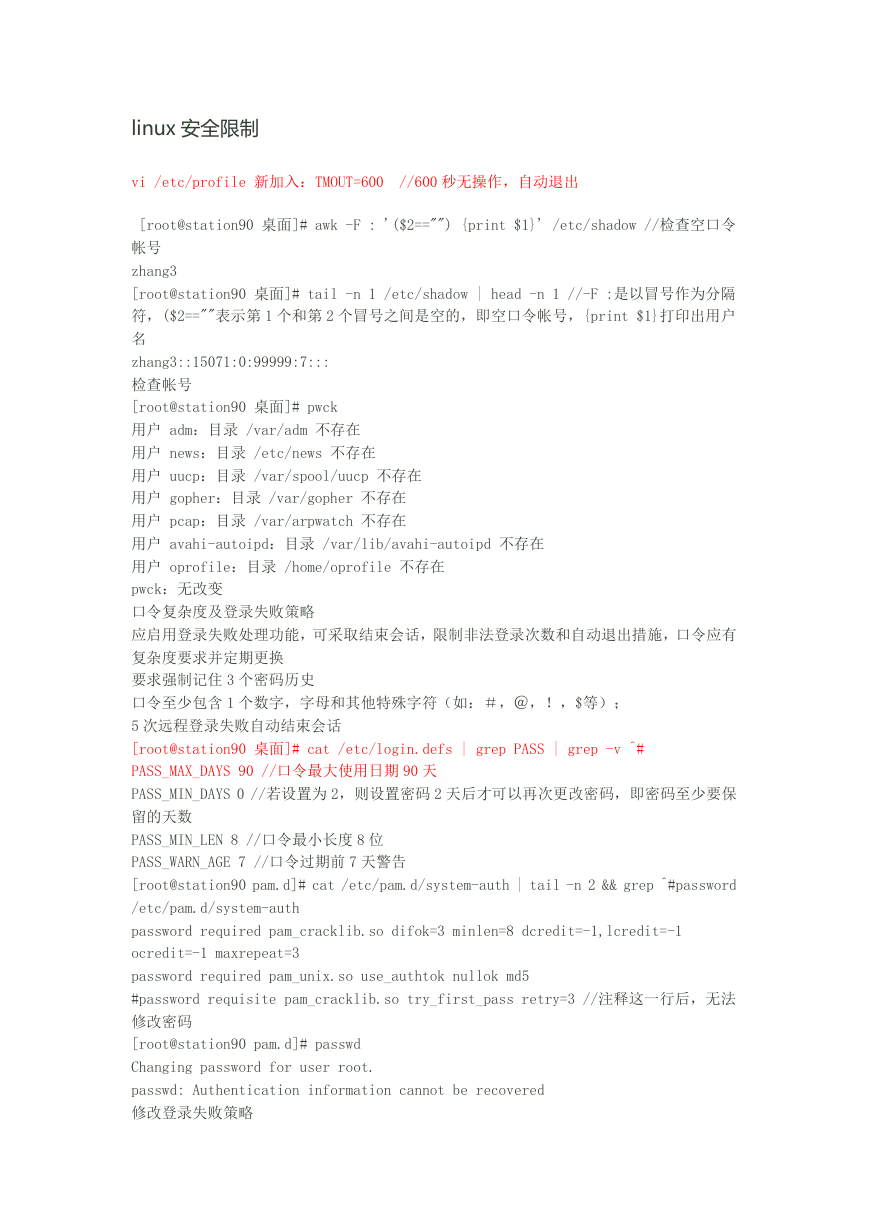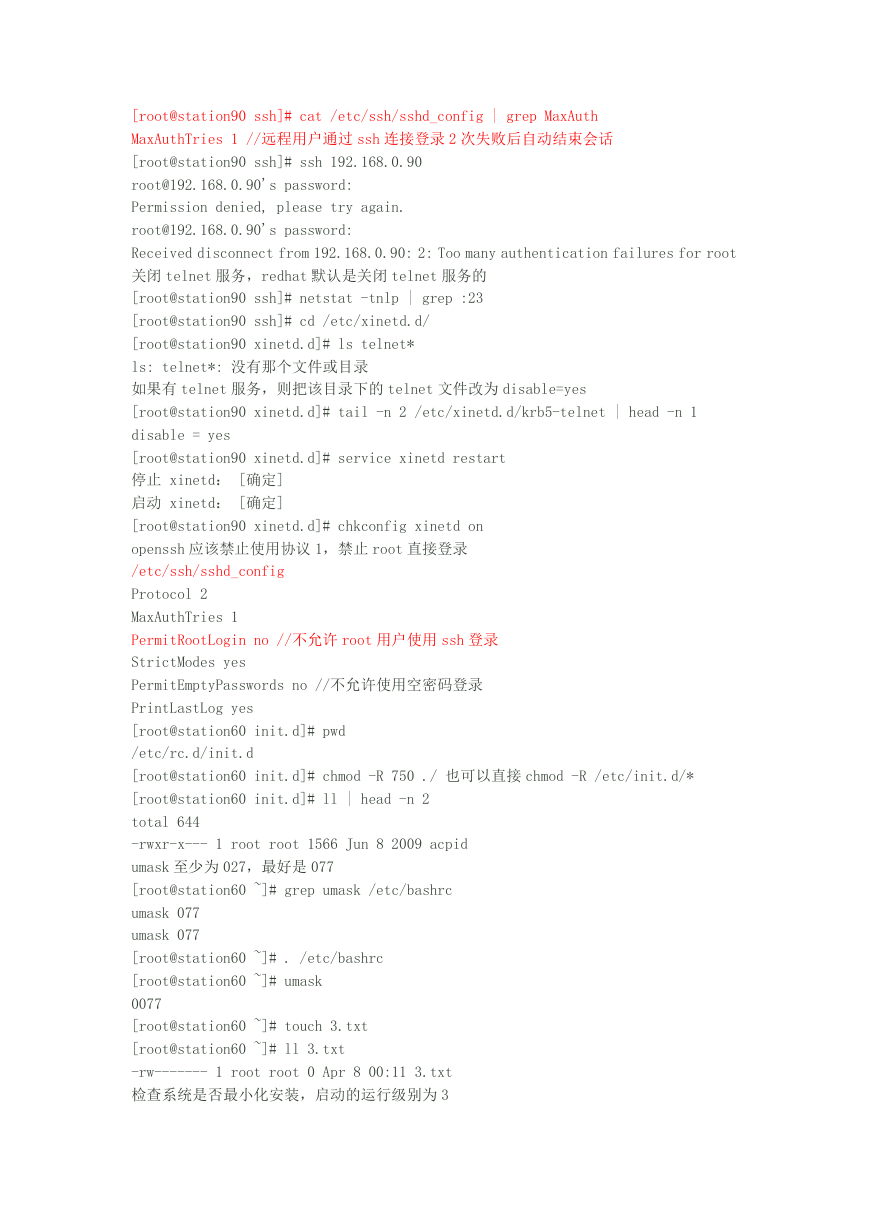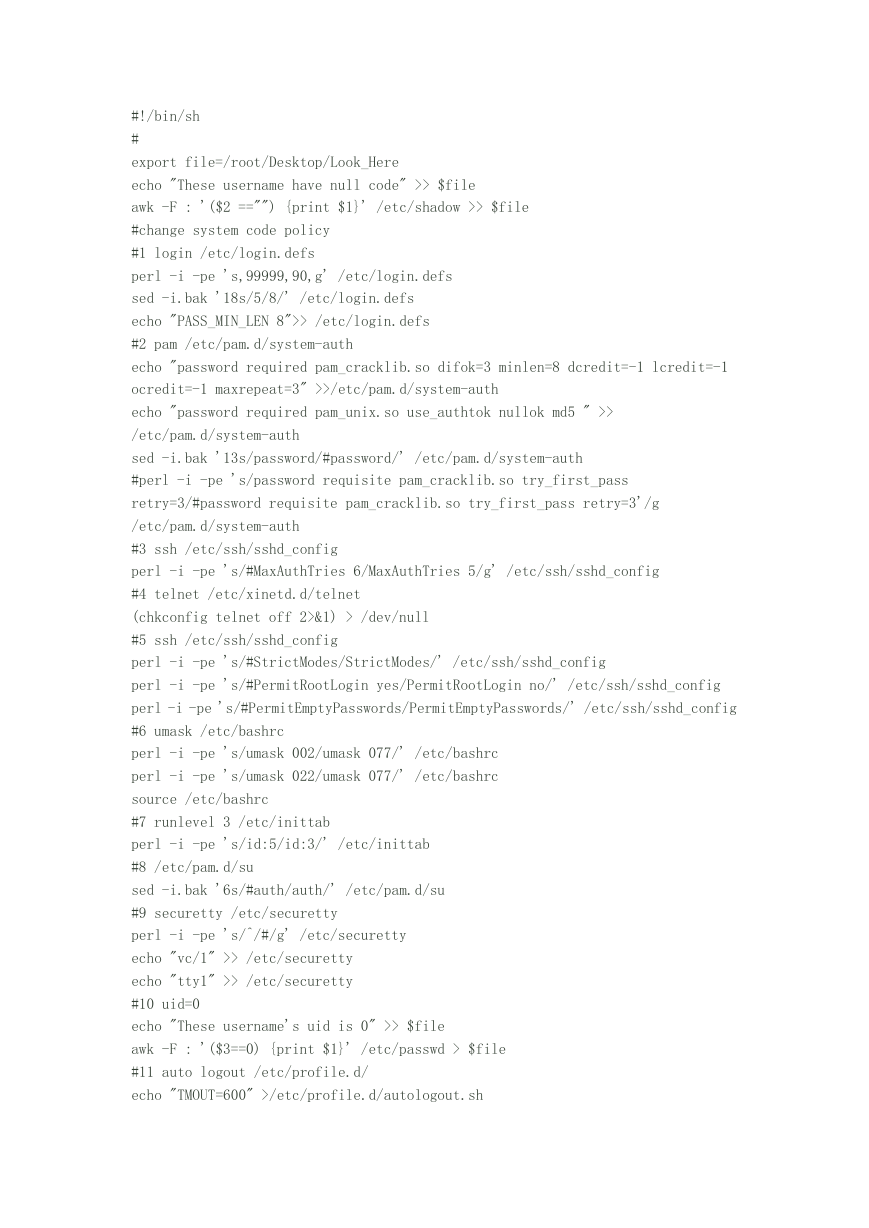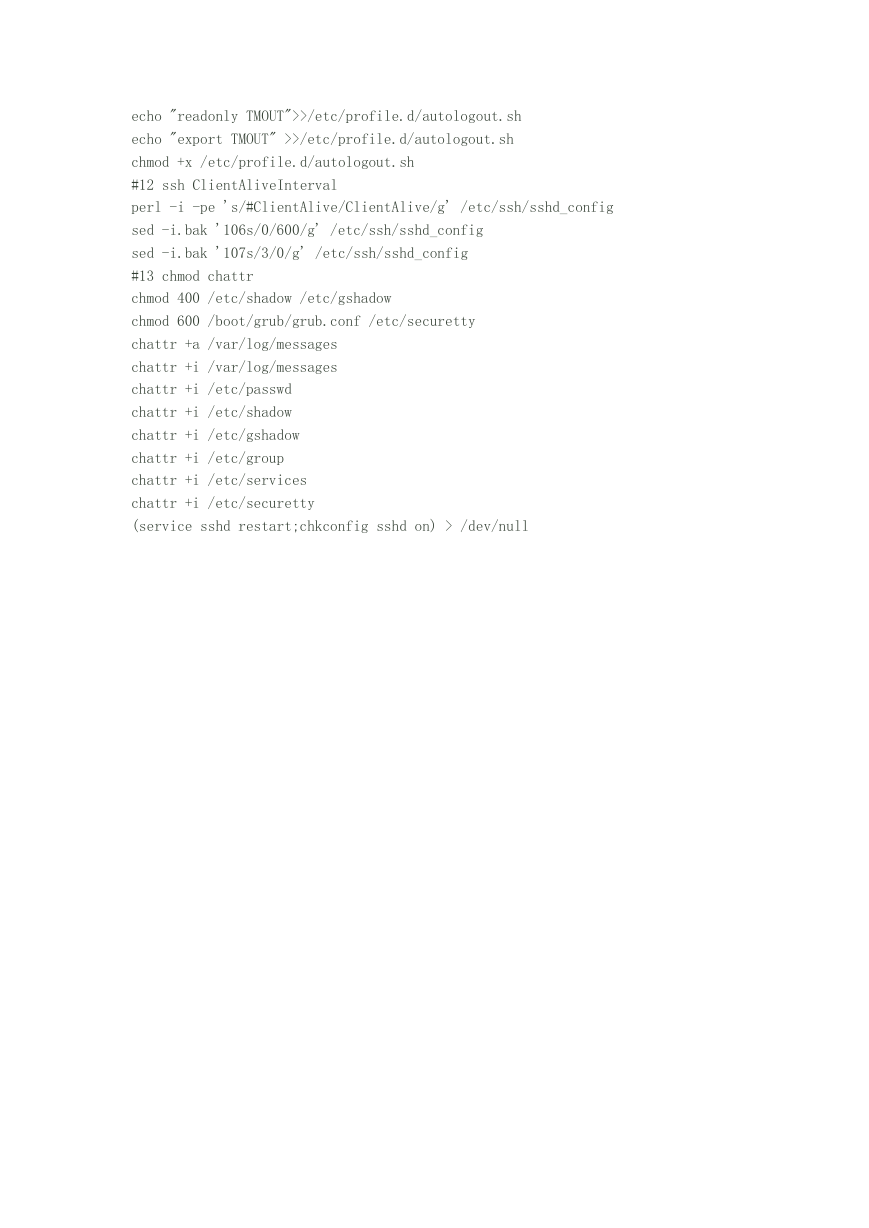linux 安全限制
vi /etc/profile 新加入:TMOUT=600
//600 秒无操作,自动退出
[root@station90 桌面]# awk -F : '($2=="") {print $1}' /etc/shadow //检查空口令
帐号
zhang3
[root@station90 桌面]# tail -n 1 /etc/shadow | head -n 1 //-F :是以冒号作为分隔
符,($2==""表示第 1 个和第 2 个冒号之间是空的,即空口令帐号,{print $1}打印出用户
名
zhang3::15071:0:99999:7:::
检查帐号
[root@station90 桌面]# pwck
用户 adm:目录 /var/adm 不存在
用户 news:目录 /etc/news 不存在
用户 uucp:目录 /var/spool/uucp 不存在
用户 gopher:目录 /var/gopher 不存在
用户 pcap:目录 /var/arpwatch 不存在
用户 avahi-autoipd:目录 /var/lib/avahi-autoipd 不存在
用户 oprofile:目录 /home/oprofile 不存在
pwck:无改变
口令复杂度及登录失败策略
应启用登录失败处理功能,可采取结束会话,限制非法登录次数和自动退出措施,口令应有
复杂度要求并定期更换
要求强制记住 3 个密码历史
口令至少包含 1 个数字,字母和其他特殊字符(如:#,@,!,$等);
5 次远程登录失败自动结束会话
[root@station90 桌面]# cat /etc/login.defs | grep PASS | grep -v ^#
PASS_MAX_DAYS 90 //口令最大使用日期 90 天
PASS_MIN_DAYS 0 //若设置为 2,则设置密码 2 天后才可以再次更改密码,即密码至少要保
留的天数
PASS_MIN_LEN 8 //口令最小长度 8 位
PASS_WARN_AGE 7 //口令过期前 7 天警告
[root@station90 pam.d]# cat /etc/pam.d/system-auth | tail -n 2 && grep ^#password
/etc/pam.d/system-auth
password required pam_cracklib.so difok=3 minlen=8 dcredit=-1,lcredit=-1
ocredit=-1 maxrepeat=3
password required pam_unix.so use_authtok nullok md5
#password requisite pam_cracklib.so try_first_pass retry=3 //注释这一行后,无法
修改密码
[root@station90 pam.d]# passwd
Changing password for user root.
passwd: Authentication information cannot be recovered
修改登录失败策略
�
[root@station90 ssh]# cat /etc/ssh/sshd_config | grep MaxAuth
MaxAuthTries 1 //远程用户通过 ssh 连接登录 2 次失败后自动结束会话
[root@station90 ssh]# ssh 192.168.0.90
root@192.168.0.90's password:
Permission denied, please try again.
root@192.168.0.90's password:
Received disconnect from 192.168.0.90: 2: Too many authentication failures for root
关闭 telnet 服务,redhat 默认是关闭 telnet 服务的
[root@station90 ssh]# netstat -tnlp | grep :23
[root@station90 ssh]# cd /etc/xinetd.d/
[root@station90 xinetd.d]# ls telnet*
ls: telnet*: 没有那个文件或目录
如果有 telnet 服务,则把该目录下的 telnet 文件改为 disable=yes
[root@station90 xinetd.d]# tail -n 2 /etc/xinetd.d/krb5-telnet | head -n 1
disable = yes
[root@station90 xinetd.d]# service xinetd restart
停止 xinetd: [确定]
启动 xinetd: [确定]
[root@station90 xinetd.d]# chkconfig xinetd on
openssh 应该禁止使用协议 1,禁止 root 直接登录
/etc/ssh/sshd_config
Protocol 2
MaxAuthTries 1
PermitRootLogin no //不允许 root 用户使用 ssh 登录
StrictModes yes
PermitEmptyPasswords no //不允许使用空密码登录
PrintLastLog yes
[root@station60 init.d]# pwd
/etc/rc.d/init.d
[root@station60 init.d]# chmod -R 750 ./ 也可以直接 chmod -R /etc/init.d/*
[root@station60 init.d]# ll | head -n 2
total 644
-rwxr-x--- 1 root root 1566 Jun 8 2009 acpid
umask 至少为 027,最好是 077
[root@station60 ~]# grep umask /etc/bashrc
umask 077
umask 077
[root@station60 ~]# . /etc/bashrc
[root@station60 ~]# umask
0077
[root@station60 ~]# touch 3.txt
[root@station60 ~]# ll 3.txt
-rw------- 1 root root 0 Apr 8 00:11 3.txt
检查系统是否最小化安装,启动的运行级别为 3
�
查看/etc/pam.d/su 是否包含以下两行
auth sufficient pam_rootok.so
# Uncomment the following line to implicitly trust users in the "wheel" group.
#auth sufficient pam_wheel.so trust use_uid
# Uncomment the following line to require a user to be in the "wheel" group.
auth required pam_wheel.so use_uid //上面的注释已经说的很清楚了,没有注释下面这
一行,那么要 su 到别的用户就必须在 wheel 组中
[root@station60 pam.d]# gpasswd -a oracle wheel
Adding user oracle to group wheel
[root@station60 pam.d]# id oracle
uid=500(oracle) gid=500(oracle) groups=500(oracle),0(root),10(wheel)
context=system_u:system_r:unconfined_t
[root@station60 pam.d]# id zhang3
uid=501(zhang3) gid=501(zhang3) groups=501(zhang3)
context=system_u:system_r:unconfined_t
[root@station60 pam.d]# su - zhang3
[zhang3@station60 ~]$ su - root //以下密码输入都是正确的
Password:
su: incorrect password
[zhang3@station60 ~]$ su - oracle
Password:
su: incorrect password
[zhang3@station60 ~]$ su - oracle
Password:
su: incorrect password
[zhang3@station60 ~]$ su - oracle
Password:
su: incorrect password
[zhang3@station60 ~]$
[oracle@station60 ~]$ su - oracle
Password:
[oracle@station60 ~]$ su - root
Password:
[root@station60 ~]#
操作指南 1.本地登录用户参考配置操作
#cd /etc/profile.d
执行
#vi autologout.sh
加入如下内容:
TMOUT=600
readonly TMOUT
export TMOUT
保存退出,系统将在用户闲置 10 分钟后自动注销。
2.远程登录用户参考配置操作
�
#vi /etc/ssh/sshd_config
将以下内容设置为:
ClientAliveInterval 600
ClientAliveCountMax 0
以上表示 10 分钟闲置后,自动注销并结束会话。
检测方法 1、判定条件
查看帐号超时是否自动注销;
2、检测操作
cat /etc/ssh/sshd_config
检查其中两个参数设置:
ClientAliveInterval 600
ClientAliveCountMax 0
(2)执行:awk -F: '($3 == 0) { print $1 }' /etc/passwd
返回值包括“root”以外的条目,说明有其他超级用户,低于安全要求。
2、检测操作
执行:awk -F: '($3 == 0) { print $1 }' /etc/passwd
返回值包括“root”以外的条目,说明有其他超级用户;
/etc/securetty 文件设置 root 登陆的 tty 和 vc(虚拟控制台)设备。/etc/securetty 文
件被 login 程序读 (通常 /bin/login)。它的格式是允许的 tty 和 vc 列表,注释掉或不出
现的设备,不允许 root 登陆。
vc/1
#vc/2
#vc/3
#vc/4
#vc/5
#vc/6
#vc/7
#vc/8
#vc/9
#vc/10
#vc/11
tty1
#tty2
#tty3
#tty4
#tty5
#tty6
#tty7
#tty8
#tty9
#tty10
#tty11
root 只能从 tty1 和 vc 登陆。建议仅允许 root 从一个 tty 或 vc 登陆,如果需要更多设备
登陆,使用 su 命令转换为 root。
�
#!/bin/sh
#
export file=/root/Desktop/Look_Here
echo "These username have null code" >> $file
awk -F : '($2 =="") {print $1}' /etc/shadow >> $file
#change system code policy
#1 login /etc/login.defs
perl -i -pe 's,99999,90,g' /etc/login.defs
sed -i.bak '18s/5/8/' /etc/login.defs
echo "PASS_MIN_LEN 8">> /etc/login.defs
#2 pam /etc/pam.d/system-auth
echo "password required pam_cracklib.so difok=3 minlen=8 dcredit=-1 lcredit=-1
ocredit=-1 maxrepeat=3" >>/etc/pam.d/system-auth
echo "password required pam_unix.so use_authtok nullok md5 " >>
/etc/pam.d/system-auth
sed -i.bak '13s/password/#password/' /etc/pam.d/system-auth
#perl -i -pe 's/password requisite pam_cracklib.so try_first_pass
retry=3/#password requisite pam_cracklib.so try_first_pass retry=3'/g
/etc/pam.d/system-auth
#3 ssh /etc/ssh/sshd_config
perl -i -pe 's/#MaxAuthTries 6/MaxAuthTries 5/g' /etc/ssh/sshd_config
#4 telnet /etc/xinetd.d/telnet
(chkconfig telnet off 2>&1) > /dev/null
#5 ssh /etc/ssh/sshd_config
perl -i -pe 's/#StrictModes/StrictModes/' /etc/ssh/sshd_config
perl -i -pe 's/#PermitRootLogin yes/PermitRootLogin no/' /etc/ssh/sshd_config
perl -i -pe 's/#PermitEmptyPasswords/PermitEmptyPasswords/' /etc/ssh/sshd_config
#6 umask /etc/bashrc
perl -i -pe 's/umask 002/umask 077/' /etc/bashrc
perl -i -pe 's/umask 022/umask 077/' /etc/bashrc
source /etc/bashrc
#7 runlevel 3 /etc/inittab
perl -i -pe 's/id:5/id:3/' /etc/inittab
#8 /etc/pam.d/su
sed -i.bak '6s/#auth/auth/' /etc/pam.d/su
#9 securetty /etc/securetty
perl -i -pe 's/^/#/g' /etc/securetty
echo "vc/1" >> /etc/securetty
echo "tty1" >> /etc/securetty
#10 uid=0
echo "These username's uid is 0" >> $file
awk -F : '($3==0) {print $1}' /etc/passwd > $file
#11 auto logout /etc/profile.d/
echo "TMOUT=600" >/etc/profile.d/autologout.sh
�
echo "readonly TMOUT">>/etc/profile.d/autologout.sh
echo "export TMOUT" >>/etc/profile.d/autologout.sh
chmod +x /etc/profile.d/autologout.sh
#12 ssh ClientAliveInterval
perl -i -pe 's/#ClientAlive/ClientAlive/g' /etc/ssh/sshd_config
sed -i.bak '106s/0/600/g' /etc/ssh/sshd_config
sed -i.bak '107s/3/0/g' /etc/ssh/sshd_config
#13 chmod chattr
chmod 400 /etc/shadow /etc/gshadow
chmod 600 /boot/grub/grub.conf /etc/securetty
chattr +a /var/log/messages
chattr +i /var/log/messages
chattr +i /etc/passwd
chattr +i /etc/shadow
chattr +i /etc/gshadow
chattr +i /etc/group
chattr +i /etc/services
chattr +i /etc/securetty
(service sshd restart;chkconfig sshd on) > /dev/null
�












 2023年江西萍乡中考道德与法治真题及答案.doc
2023年江西萍乡中考道德与法治真题及答案.doc 2012年重庆南川中考生物真题及答案.doc
2012年重庆南川中考生物真题及答案.doc 2013年江西师范大学地理学综合及文艺理论基础考研真题.doc
2013年江西师范大学地理学综合及文艺理论基础考研真题.doc 2020年四川甘孜小升初语文真题及答案I卷.doc
2020年四川甘孜小升初语文真题及答案I卷.doc 2020年注册岩土工程师专业基础考试真题及答案.doc
2020年注册岩土工程师专业基础考试真题及答案.doc 2023-2024学年福建省厦门市九年级上学期数学月考试题及答案.doc
2023-2024学年福建省厦门市九年级上学期数学月考试题及答案.doc 2021-2022学年辽宁省沈阳市大东区九年级上学期语文期末试题及答案.doc
2021-2022学年辽宁省沈阳市大东区九年级上学期语文期末试题及答案.doc 2022-2023学年北京东城区初三第一学期物理期末试卷及答案.doc
2022-2023学年北京东城区初三第一学期物理期末试卷及答案.doc 2018上半年江西教师资格初中地理学科知识与教学能力真题及答案.doc
2018上半年江西教师资格初中地理学科知识与教学能力真题及答案.doc 2012年河北国家公务员申论考试真题及答案-省级.doc
2012年河北国家公务员申论考试真题及答案-省级.doc 2020-2021学年江苏省扬州市江都区邵樊片九年级上学期数学第一次质量检测试题及答案.doc
2020-2021学年江苏省扬州市江都区邵樊片九年级上学期数学第一次质量检测试题及答案.doc 2022下半年黑龙江教师资格证中学综合素质真题及答案.doc
2022下半年黑龙江教师资格证中学综合素质真题及答案.doc